PowerPoint 2010 -
Saving and Printing

PowerPoint 2010
Saving and Printing


/en/powerpoint2010/presenting-slide-show/content/
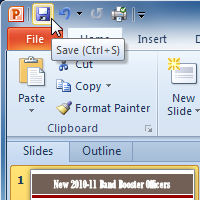
Are you saving for the first time? Do you need to share your presentation with someone who doesn't have PowerPoint 2010? Would you like to print handouts of your presentation? Do you need a printout that shows your notes with your slides? All of these factors will affect how you save and print your PowerPoint presentations.
In this lesson, you'll learn how to use the Save and Save As commands, in addition to learning how to save in alternative file formats. We'll also cover all of the printing tasks and settings in the Print pane, along with the Quick Print feature.
When you create a new presentation in PowerPoint, you'll need to know how to save it in order to access and edit it later. PowerPoint allows you to save your presentations in several ways.
Once you've created your document, you may want to print it to view and share your work offline. It's easy to preview and print a document in Word using the Print pane.
Optional: You can download this example for extra practice.
Save As allows you to choose a name and location for your presentation. It's useful if you've first created a presentation or if you want to save a different version of a presentation while keeping the original.
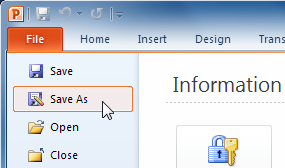 Save As
Save As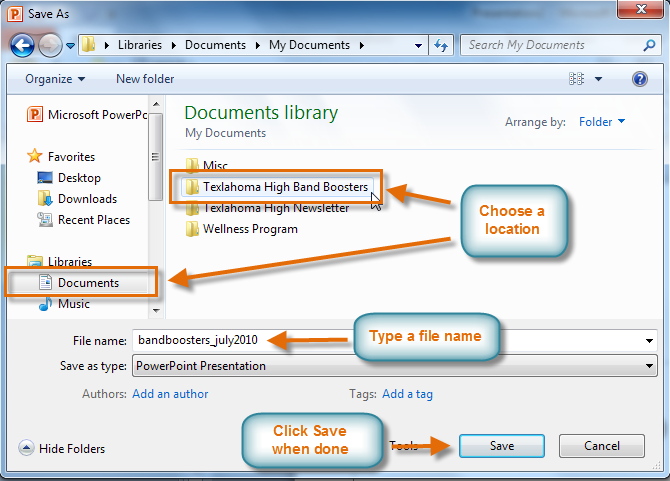 The Save As dialog box
The Save As dialog boxIf you're using Windows 7, you'll usually want to save things to your Documents library, and in other versions of Windows you'll save them to the My Documents folder. For more information, check out our lessons on Windows 7 and Windows XP.
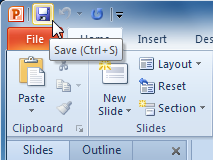 Saving a presentation
Saving a presentationIf you are saving for the first time and select Save, the Save As dialog box will appear.
PowerPoint automatically saves your presentation to a temporary folder while you're working on it. If you forget to save your changes or if PowerPoint crashes, you can recover the autosaved file.
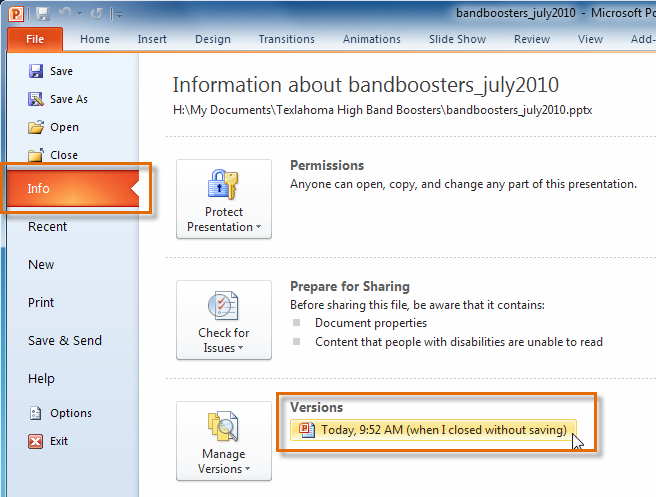 Opening an autosaved file
Opening an autosaved file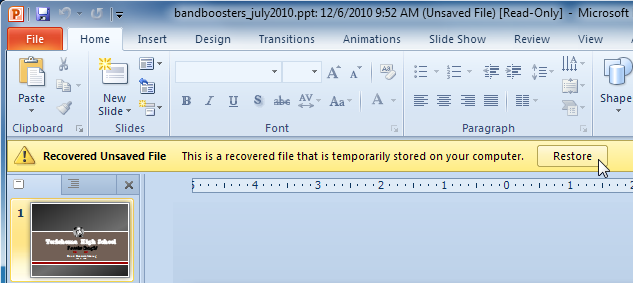 Restoring a file
Restoring a fileBy default, PowerPoint autosaves every 10 minutes. If you are editing a presentation for less than 10 minutes, PowerPoint may not create an autosaved version.
You can share your presentation with anyone using PowerPoint 2010 or 2007 because they use the same file format. However, earlier versions of PowerPoint use a different file format, so if you want to share your presentation with someone using an earlier version of PowerPoint you'll need to save it as a PowerPoint 97-2003 presentation.
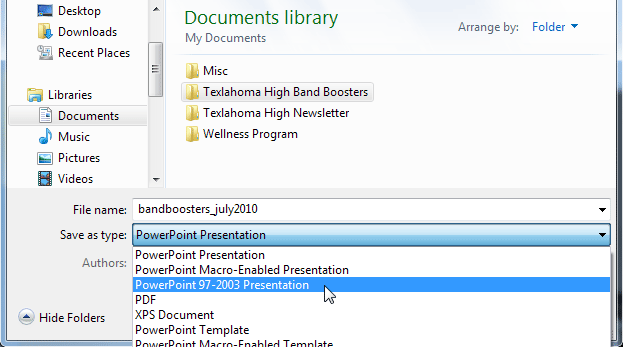 Saving as a PowerPoint 97-2003 presentation
Saving as a PowerPoint 97-2003 presentationIf you want to share your presentation with someone who doesn't have PowerPoint, you have several file types to choose from.
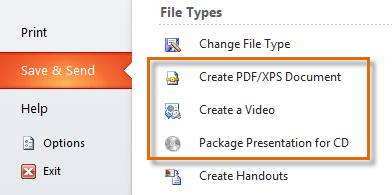 Selecting a different file type
Selecting a different file typeIn previous versions of PowerPoint, there was a Print Preview option that allowed you to see exactly what the presentation looked like before printing it. You may have noticed that this feature seems to be gone in PowerPoint 2010. It actually hasn't disappeared; it has just been combined with the Print window to create the Print pane, which is located in Backstage view.
Click the buttons in the interactive below to learn about the various printing settings and options found in the Print pane.
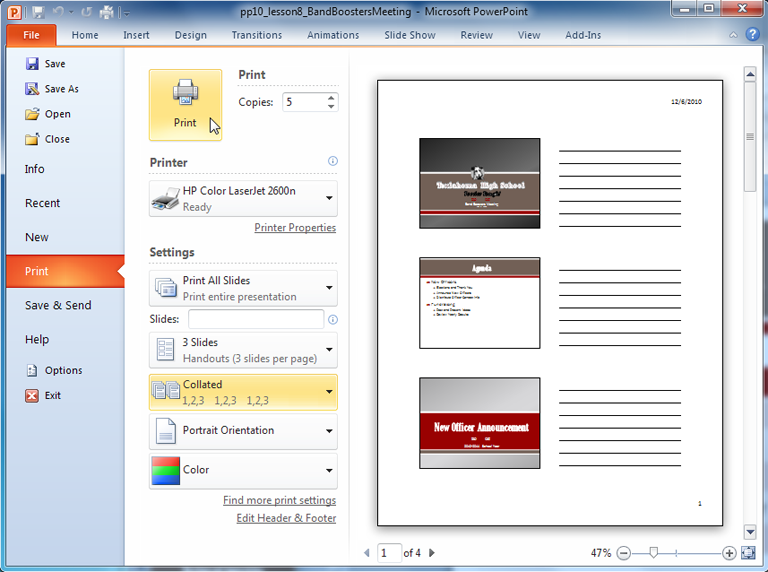
Click the arrows to advance and view the pages of your presentation in the Print Preview area.
Before printing, you can preview your presentation and adjust settings if needed.
When you're ready, enter the number of copies you need and click the Print button to print your presentation.
The Print Preview pane allows you to see how your presentation will look when printed.
You may need to select a specific printer if your computer is connected to multiple printers.
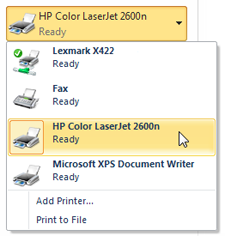
Here, you can choose whether to print all of the slides in your presentation or a specific selection of slides.
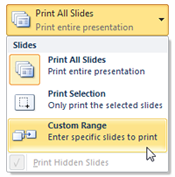
If you want to print a custom range of slides, enter the slide numbers here.

Here, you can choose how you want your presentation to appear on the page.
Options include printing the full-page slide or slides with notes or displaying multiple slides in handouts.
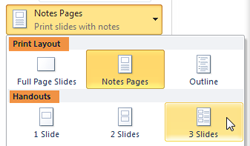
If you are printing multiple copies, you can choose whether you want the copies collated or uncollated.
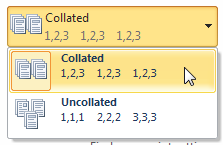
Here, you can change your print color, which is chosen by default depending on whether you are using a black and white or color printer.
Because presentations use a lot of color, you may want to print in grayscale or black and white to save ink.

Here, you can choose your page orientation as portrait or landscape.
If you're printing a full-page slide, you may want to choose landscape for a better fit on the page.

You can drag the slider to zoom the Print Preview. If you zoom out, you can view multiple pages at the same time.
There may be times when you want to print something with a single click using Quick Print. This feature prints the document using the default settings and the default printer. In PowerPoint 2010, you'll need to add it to the Quick Access toolbar in order to use it.
Quick Print always prints the entire presentation, so if you only want to print part of your presentation you'll have to use the Print pane.
 Adding Quick Print to the Quick Access toolbar
Adding Quick Print to the Quick Access toolbar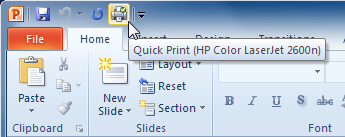 The Quick Print command
The Quick Print command/en/powerpoint2010/modifying-lists/content/